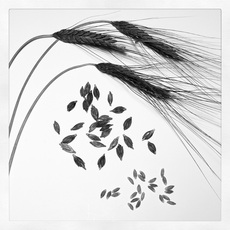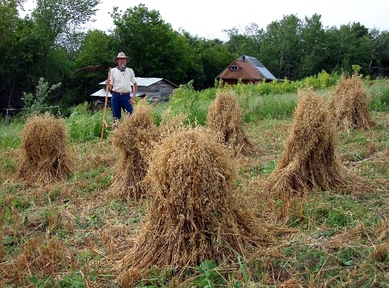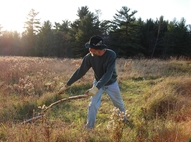 Black Winter Emmer Black Winter Emmer Ever wonder how to get the hulls off of your homegrown Einkorn and Emmer, so you can eat them? I have heard of this solution, but I haven't tried it yet. Here is a video on YouTube of a simple way to do it. At 1:00, notice that a thick, flat rubber ring has been mounted over the main steel plate of a Corona or Porkert grain mill. The other steel plate is left bare. The grain heads are cut off the stems, and then run through the grinder. The plates need to be adjusted for firm, but not crushing pressure. As you turn the crank, the metal teeth of the steel plate, rubs the hulled grain against the rubber plate, and the friction rubs the hulls apart. Then the grain is separated from the chaff, by winnowing it in the wind. On an even smaller scale, you can use the ancient method of toasting the hulls in a frying pan until very dry, then crushing the hulls with a mortar and pestle, and then winnow in the wind to separate the grain from the chaff. - Botan Anderson
2 Comments
In 2009 I had another opportunity to lead a grain harvest/experiment. This time, one of my Spring Scythe Workshop participants had a field of oats that she had had planted on her land as a nurse crop for hay. She wanted to try to harvest some of it with a scythe. So we organized a workshop for it. The nice thing about having a grain harvest workshop with oats, was that we had a much greater window of opportunity in which to harvest the grain, compared to other grains. Oats don't fall off as easily, when ripe. This extended time-frame made it easier to schedule a workshop, and also to work around the weather.
Below is some of the best info on harvesting grains with a scythe, that I've ever come across. It's three videos that I discovered on YouTube. Part 1 - In the video above, some old-timers get together to demonstrate how they used to harvest grain in the old-days. At 3:00 and 3:54, notice the type of grain-cradle that is used with the "Austrian" scythe. Also notice at 3:14, that he is mowing, what I call "into the wall" with each stroke. The cut stems are gathered and pressed against the standing stems by the grain-cradle, to help them stay in line. This makes it easier to gather into uniform sheaves.
|
Botan AndersonArchives
March 2023
Categories
All
|


 RSS Feed
RSS Feed